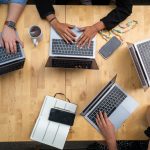Transform Your Retail Space with Eye-Catching Display Strategies
In the competitive world of retail, creating an engaging and memorable shopping experience is crucial for attracting and retaining customers. One of the most effective ways to achieve this is through the strategic use of in-store displays. Here, we will explore the various techniques and strategies that can help you transform your retail space into a captivating and sales-driven environment.
The Power of In-Store Displays
In-store displays are more than just a way to showcase products; they are a powerful tool for driving sales, enhancing customer engagement, and building brand loyalty. A study by Brigham Young University found that strategically designed displays can increase sales by an astonishing 540% compared to unorganized presentations1.
Sujet a lire : Elevate your store's appeal with effective displays
Effective color usage in displays can also significantly impact brand recognition, with the Color Marketing Group reporting a boost of up to 80% in brand recognition through effective color use1. Moreover, in-store displays have a higher recall rate compared to digital advertisements, with a 10% higher recall rate reported by the Point of Purchase Advertising International (POPAI)1.
Real-World Success Stories
To illustrate the impact of well-designed displays, let’s look at two retail giants that have mastered the art of display optimization:
Dans le meme genre : What Precise Methods Can UK Urban Farmers Use to Monitor Soil Quality?
IKEA
IKEA is renowned for its immersive showroom displays. By creating fully furnished room setups, IKEA allows customers to visualize how products would look and function in their own homes. This strategy not only inspires customers but also encourages them to purchase multiple items to recreate the look. According to Forbes, IKEA’s showroom displays contribute to an average customer spend of $60 per visit1.
Sephora
Sephora has revolutionized the in-store experience through interactive displays. The “Beauty Hub” features digital screens that offer personalized product recommendations based on customer preferences. The displays also include virtual try-on technology, allowing customers to experiment with different makeup looks. This immersive experience has led to a reported 11% increase in sales and a 5% boost in customer loyalty1.
Mastering Display Fundamentals
To create impactful displays, retailers must first master the fundamentals of visual merchandising.
Layout and Product Placement
The layout of your displays plays a crucial role in guiding customer behavior. By strategically placing high-margin products at eye level and using color blocking techniques, you can draw attention to priority items. The “Rule of Three” is a popular principle in visual merchandising, suggesting that grouping products in threes creates a more appealing and memorable display1.
| Technique | Description | Benefits |
|---|---|---|
| Color Blocking | Using contrasting colors to group products | Draws attention, enhances visual appeal |
| Rule of Three | Grouping products in threes | Creates a more appealing and memorable display |
| Eye-Level Placement | Placing high-margin products at eye level | Increases visibility and sales |
Lighting and Ambiance
Lighting is not just a functional element but also a powerful tool for creating ambiance and highlighting products. Consider using a mix of ambient, task, and accent lighting to create depth and dimension. Spotlighting key products or using backlighting to create a halo effect can add drama and focus to your displays1.
Storytelling and Themes
Effective displays tell a story and evoke emotions. By creating themed displays that align with your brand identity and resonate with your target audience, you can forge deeper connections with customers. For example, a beach-themed display for summer products can transport customers to a vacation state of mind and inspire purchases1.
Creative Retail Wall Display Ideas
In addition to mastering the fundamentals, incorporating creative and flexible display ideas can further enhance your retail space.
Pegboard Walls
Pegboard walls are ideal for small to medium-sized products that can be hung, such as phone accessories or tools. These displays are flexible and can be easily rearranged for different marketing campaigns. However, ensure the pegboard is well-mounted and avoid overloading it with products2.
Floating Shelves
Floating shelves are perfect for displaying a wide array of products, including shoes, handbags, and bric-a-brac. They offer a refined, minimalist appearance and can be arranged in any design suitable for your space. Aim for order and symmetry to make the display more eye-catching2.
Slat Wall Displays
Slat walls are versatile and can be made of wood, metal, or a combination of both. They allow for the use of hooks, hanging rods, and other accessories to hang products. Adding tasteful lighting along some slats can significantly enhance the display2.
Tiered Wall Displays
Tiered wall displays offer lots of display space and simplify product arrangement. These can be customized to prioritize certain products and create a dramatic display effect. They are particularly useful for small shops looking to maximize their display space2.
Mapping the Customer Journey
Understanding and catering to the customer journey is essential for optimizing your displays.
Analyzing Traffic Flow
By analyzing traffic flow patterns and identifying high-traffic areas, you can strategically place displays for maximum impact. Heat mapping technology can provide valuable insights into customer behavior and dwell time, enabling data-driven placement decisions for product displays1.
Guiding Customers Through the Store
Your displays should guide customers through the store, encouraging exploration and discovery. Placing complementary products together and creating cross-merchandising opportunities can increase average basket size and drive impulse purchases. For instance, displaying a coordinated outfit alongside accessories can inspire customers to purchase the complete look1.
Leveraging Lighting and Signage Effectively
Lighting and signage are critical components of an effective retail display strategy.
Effective Lighting
Quality, strategically placed lighting can highlight specific products or areas within the store. For key displays, consider using spotlights or accent lighting to draw the customer’s eye immediately to targeted merchandise. Different types of lighting can also evoke various moods, such as warm lighting for a cozy environment or cooler lighting for a modern feel3.
Clear Signage
Clear signage is paramount for ensuring that customers can navigate the store seamlessly. Use a hierarchy of signage with larger signs for main sections and smaller ones to indicate specific products or promotions within those sections. Incorporating digital signage can further capture attention, as it allows for dynamic messaging that can change frequently based on inventory, sales, or seasons3.
Offering Interactive Elements
Incorporating interactive elements into your displays can significantly enhance the shopping experience.
Hands-On Trials and Demonstrations
Transform passive shopping into an experience by allowing customers to touch and try out products. Setting up sample stations for food products or offering hands-on trials of beauty items can create memorable interactions with your brand. If space allows, consider utilizing small demonstration areas where employees can conduct short demonstrations to show the uses and benefits of specific products3.
Interactive Digital Displays
Interactive screens can provide customers with more information about your brand, pricing, and products. You can install apps that give shoppers mock-ups of how they may look when wearing certain items, which can help customers make purchasing decisions. These displays can be used independently or alongside other product displays to enhance the shopping experience2.
Creating Effective Window Displays
Window displays are the first impression customers get of your store, making them a crucial aspect of your retail strategy.
Understand Your Location
The location of your shop significantly affects how you organize your window display. For busy streets, you may need to employ smaller products and signage that are meant to be enjoyed up close. In less walkable areas, you can focus on more detailed displays5.
Create a Clear Concept
A deliberate subject or theme will always work in your favor. It connects everything and captures the user’s attention more quickly. For example, spring window display ideas can be organized around holidays and festivals to attract customers5.
Place Key Items at Eye Level
The main focus of your store window display must be placed at people’s eye level. This could be an accessory, an outfit, or a structure that attracts people’s first attention and brings them into your store5.
Practical Insights and Actionable Advice
Here are some practical tips to help you transform your retail space:
- Prioritize Customer-Centricity: Understand your target audience and tailor your displays to their preferences and behaviors.
- Embrace Technology: Incorporate interactive elements and digital innovations to create seamless, omnichannel experiences.
- Measure and Iterate: Continuously track the performance of your displays and make data-driven decisions to refine your strategies.
- Stay Agile: Adapt to changing consumer behaviors, seasonal trends, and industry developments to stay relevant and competitive1.
Conclusion and Next Steps
In-store displays are a powerful tool for driving sales, engagement, and brand loyalty. By combining timeless visual merchandising strategies with cutting-edge innovations, retailers can create immersive experiences that captivate customers and differentiate their brand.
As you embark on your journey to optimize your in-store displays, remember to stay focused on your customers, leverage technology, measure performance, and stay agile. Here is a summary of key takeaways:
- Use Strategic Display Layouts: Employ techniques like color blocking and the Rule of Three to create visually appealing displays.
- Leverage Lighting and Signage: Use lighting to create ambiance and highlight products, and ensure clear signage to guide customers through the store.
- Offer Interactive Elements: Incorporate hands-on trials, demonstrations, and interactive digital displays to enhance customer engagement.
- Create Effective Window Displays: Tailor your window displays to your location and create a clear concept that captures attention.
By implementing these strategies, you can transform your retail space into a dynamic and engaging environment that attracts and retains customers, ultimately driving business success.
For more tips on optimizing your retail space, consider exploring resources such as retail optimization guides to further enhance your visual merchandising strategies.












